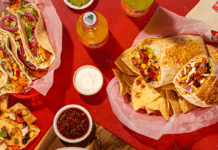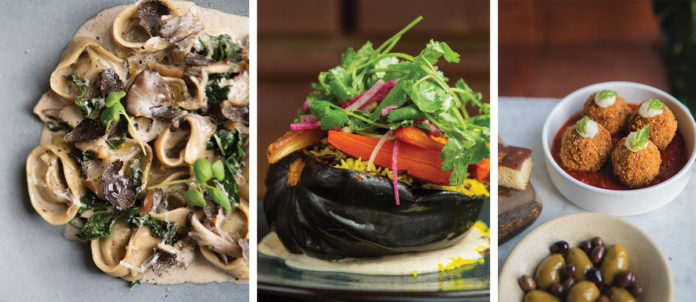We all know what a plant-based diner looks like…under 35, female, a bit of a ‘hippie’ even? If you think that is today’s plant-forward diner, then think again, because this growing market includes people from all ages, ethnic backgrounds and experience.
With the number of vegans and vegetarians in Canada remaining relatively unchanged at seven to eight per cent, the main drivers of this growing market are ‘lessitarians’ or individuals who choose to eat less meat, dairy or other animal products. As explained by Jo-Ann McArthur, president of Nourish Food Marketing in Toronto, “A lessitarian is someone that chooses to reduce their overall animal-product consumption. It’s this 50 per cent of Canadians that’s driving the increased interest, number and expectations of the plant-based market.”
Fraser Fitzgerald, plant-based chef and owner of That Planted Fork (TPF) in Hamilton, Ont. has seen a similar shift in his customer demographic. “Today I have two main types of customers at my retail and wholesale outlet at The Hamilton Farmers Market and in my cooking classes. Approximately 50 per cent are plant-based [eaters] themselves, while the others are either interested in trying a new style of cooking, want to follow a healthier lifestyle or do something that is good for our planet.”
Fitzgerald uses social media as well as community media to promote his menus and products.
Popular items at TPF’s Hamilton location include plant-forward sausage rolls ($4/roll or $15.95/package) and its line of dips and sauces, including top-selling caramelized onion ($7).
Jennifer Coburn, owner of Gia Restaurant, a plant-forward restaurant in Toronto, sees an even more direct trend. “Over 85 to 90 per cent of our diners are not vegan or vegetarian themselves. Instead, they’re people looking for a delicious and enjoyable dining experience that just happens to be plant-forward.”
Restaurateurs and chefs at traditional-style restaurants agree. Ryan Lister, executive chef at Oliver & Bonacini Hospitality (O&B), says, “We offer a variety of plant-forward menu items for each day and meal part to ensure everyone has a delicious menu option. Plant-based menu items make up to 20 per cent of our total revenues, so they’re important not only for our customers, but for our operations as well.”
At O&B’s Liberty Commons in downtown Toronto, the top-selling appetizer is Maple-Sriracha Cauliflower. At $15, it’s also the top-priced starter. “It is the perfect blend of sweet, salty and spicy. It is also ideal for sharing.” adds Lister, whose team uses a ‘$5 off 5 Favourites’ promotion as well as social media to promote this ever-popular item.
Including more plant-based menu items has other advantages to restaurants beyond making them the destination of choice. “The lower food cost (15 to 20 per cent) versus closer to 30 per cent for traditional items is another benefit. However, plant-forward items often require more preparation. A good example of this is our Smoked Eggplant Steak ($20) which we brine, smoke, press, marinate then grill before serving,” adds Lister.
Matthew Ravenscroft, executive chef at Toronto’s Gia Restaurant sees chefs across Canada continue to embrace and experiment with plant-based centre-of-the plate menu creations. “Plants are a wonderful canvas to express a chef’s creativity. It’s exciting to see a piece of squash transform into the main focal point of the plate. It’s this transformation that offers chefs and diners the greatest opportunity for food innovation.”
At Gia, top-selling plant-forward starters include Panko-Crusted Meatballs ($18) and Organic Crab Cakes ($25). “We mainly use social media and our waitstaff to promote each of our menu items. We also test new menu items as a special first to gather customer feedback then use this to enhance it further,” explains Ravenscroft, adding “Many of our ‘lessitarian’ diners are curious. Restaurants are often the first place they try a plant-forward item. They recognize the benefits to their health and the health of our planet of a plant-based diet, however still want the same exceptional service, wines, decor and experience they would enjoy at traditional restaurants.”
This is particularity true of boomers and seniors. According to the 2022 Nourish Food Marketing Trend Report, the senior segment accounts for nearly seven million Canadians, many whom are adopting a ‘lessitarian’ lifestyle as they look for menu choices which reflect their focus on their own and our planet’s health. However, while they might choose a plant-based menu item, they are not willing to give up their desire for familiar foods. “Food is so memory-based and people, particularly seniors, don’t want to give up their fond memories or dining experiences just because they choose a plant-based menu item. One of my primary focuses is to make plant-based menu items that look, feel and taste even better than their animal-based version,” explains Fitzgerald.
All About Indulgence
McArthur agrees. “When people go to a restaurant, they want an indulgent dining experience. Plant-based dining is not about what people cannot have, it is about what they can. This is particularly true for men because vegetarian and vegan language traditionally talked about what it does not have (eg. meatless). This needs to change to continue to grow this market.”
And while restaurant chefs create innovative plant- and legumes-based centre-of-the-plate menus, meat and seafood analogs will remain the focus for many foodservice operations, including QSR’s and casual-dining establishments. Foodservice suppliers have played a key role in supporting this growth, introducing an ever-expanding list of plant-based entrées, appetizers and desserts. “As a distributor of foodservice products, we’ve seen sustained and growing interest in plant-based dining from all segments of foodservice. What began primarily in the education sector and niche dining has expanded in recent years to be embraced by every type of restaurant and food-away-from home business,” says Emily Ferguson, director of Marketing for Sysco Foodservice Canada.
New Markets, New Innovations
While centre-of-the-plate and other meal-part options are almost limitless for lunch and dinner, breakfast is one daypart that remains dominated by animal products — namely eggs. “There is so much opportunity to grow the plant-based breakfast market. My top-seller is my just-egg breakfast sandwich ($8),” states Fitzgerald.
When Canadians begin to return to work outside their homes, the plant-forward sandwich market is also set to explode and specialty plant-based sandwiches also present an enormous growth opportunity.
The Return to Restaurants
Research by Restaurants Canada forecasts strong growth for foodservice sales in 2022, with nearly $80-billion in revenues, 3.8-per-cent higher than pre-pandemic levels.
Even more encouraging, is a May 2021 survey by Angus Reid, which showed 89 per cent of Canadians said they’re looking forward to going out to a restaurant, while 64 per cent said going out to restaurants will be an important part of their lifestyle once the pandemic subsides.
In short: Canadians are ready to return to restaurants. And while the number and type of plant-based diners continues to grow and shift, so does the diversity, flavours and styles of menu items they’re looking for. Offering delicious and indulgent plant-based alternatives to animal-based products for every day and meal part needs to be a part of your menu to ensure your restaurant is part of Canada’s resurging restaurant market.
By Morag McKenzie

















